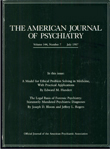Sertraline and desmethylsertraline in human breast milk and nursing infants
Abstract
OBJECTIVE: The purpose of this study was to determine the concentrations of sertraline and desmethylsertraline in both human breast milk and infant serum. METHOD: Breast milk samples from 12 women were collected at specific time intervals after oral doses of sertraline (25-200 mg once daily). For 11 mother-infant pairs, maternal serum levels 24 hours after a dose and their infants' serum levels 2-4 hours after nursing were ascertained by high-performance liquid chromatography. RESULTS: Sertraline and desmethylsertraline were present in all breast milk samples, with a gradient from "fore" milk to "hind" milk. The highest concentrations of sertraline were observed in hind milk 7-10 hours after maternal dose. Increasing the maternal dose of sertraline resulted in increased breast milk concentrations of both sertraline and desmethylsertraline. Detectable concentrations of sertraline were found in three nursing infants and desmethylsertraline in six. No adverse effects of exposure were observed in any infant. CONCLUSIONS: Sertraline and desmethylsertraline were present in the breast milk of nursing women treated with sertraline. Concentrations were affected by aliquot of milk sampled, time after maternal dose, and maternal daily dose. The infants' serum concentrations detected were below the detection limit of most commercial laboratories. The presence of desmethylsertraline in six infants' samples underscores the importance of metabolite monitoring in determining infant exposure. Estimates of daily infant exposure can be determined after analysis of sertraline and desmethylsertraline concentrations from one full breast at maternal serum steady state. Future studies of breast milk and infant serum samples should address these issues.



